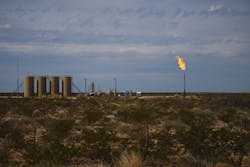Oil and gas companies with Permian basin operations continue to implement strategies to reduce greenhouse gas (GHG) emissions while continuing to supply needed barrels to energy markets.
Last year, Texas was the nation’s top oil producer, supplying 1.83 billion bbl to markets, while also leading the US in natural gas production, producing 11.2 tcf, according to a February report by Texas Independent Producers and Royalty Owners Association (TIPRO). The Permian basin plays an outsized role in both oil and gas production and emission reductions, TIPRO said.
Texans for Natural Gas, a TIPRO project, said that between 2011 and 2021, methane emissions intensity in the Permian basin fell more than 76% while production increased 345%.
Measures to mitigate GHGs have gained momentum throughout the oil and gas industry in recent years, yielding notable results, and emissions-target setting by oil and gas operators has increased, said Dzenana Tiganj, emissions analyst at Rystad Energy. Further, she told OGJ, the targets have been revised to be more aggressive.
Pneumatics, flaring
Operational improvements by Permian basin operators specifically tackling methane emissions in recent years have focused on two areas: pneumatic control device retrofitting and flaring reduction.
“They’re low-hanging fruit because they’re within direct operational control and can be addressed in the shorter term,” Tiganj said.
The US Environmental Protection Agency (EPA) calculates emissions from pneumatics based on device type, she said, moving operators to switch gas-driven high-bleed devices to low-bleed devices or to switch gas-driven devices to air- or solar-driven devices.
The move is warranted and effective. Gas-driven pneumatics used to control or operate machinery or equipment were identified in a report by consulting company Carbon Limits as the second-largest source of methane emissions in the oil and gas industry behind component leaks.
For Chevron Corp., standard infrastructure designs since 2011 have included compressed air for pneumatic controllers, eliminating natural gas venting for that application, the company told OGJ.
“The future of energy is lower carbon,” said Vanessa Ryan, methane reduction manager, Chevron.
“We’ve set ambitious targets for reducing greenhouse gas emissions, focused on achieving an overall 35% upstream intensity reduction from our 2016 baseline by 2028,” continued Ryan, who also serves as chair of The Environmental Partnership, launched in 2017 to promote practices to reduce methane emissions and now comprised of 100 oil and natural gas companies.
Chevron aspires to reach net-zero upstream emissions (Scope 1 and 2) by 2050, she said.
ExxonMobil Corp. reported having phased out all high-bleed pneumatic devices across its US unconventional production by end-2021 and has begun converting other gas-driven pneumatic devices to ones powered by electricity or compressed air.
ConocoPhillips Co. is also making this switch. Nicholas Olds, executive vice-president, Lower 48, told investors Apr. 12, 2023, that the company was eliminating gas-driven pneumatics across its operations.
He said the company has reduced its GHG intensity by 50% “through a combination of growing our low-intensity Permian assets and executing emission reduction projects across the Lower 48.” The operator says it has reduced associated gas flaring by 80% since 2019 and does not routinely flare “due to pipeline constraints in the Lower 48 or anywhere else” in its portfolio.
Across the Permian basin and elsewhere, such flaring reductions are a top driver of emissions abatement. Flaring intensity in the Permian basin has decreased more than 34% from 2020 to 2021, while the state of Texas reduced its flaring intensity by 60% between 2020 to 2021, according to TIPRO project analysis.
ExxonMobil has eliminated routine flaring in its Permian basin operations, “a key part of [the company’s] 2030 goal of achieving net-zero Scope 1 and Scope 2 greenhouse gas emissions from our unconventional operated assets,” said Darren Woods, chairman and chief executive officer, during a virtual event Apr. 4 spotlighting the company’s Low Carbon Solutions business. Woods said the company is on track to meet its goal of achieving zero routine flaring across its operated upstream assets by 2030, consistent with the World Bank Zero Routine Flaring Initiative.
Chevron, through operating practices, also is taking steps to achieve its target of zero routine flaring by 2030. The company set an upstream methane-intensity target of 2.0 kg CO2e/boe by 2028, a 53% reduction from its 2016 baseline, methane reduction manager Ryan detailed.
Noting results of the company’s lower carbon work to date, Chevron’s US methane intensity for upstream production in 2022 was 64% lower than the US upstream production sector average, she said, and its Permian carbon intensity is around 15 kg of CO2-equivalent/bbl, some two-thirds lower than the global industry average, she continued.
Equipment and design account for a portion of the reduction. Currently, 100% of Chevron’s Permian drill-rig fleet uses natural gas or electricity, reducing both CO2 emissions and well costs. Ryan said the company is working toward a 40% goal of grid-supplied power sourced from wind and solar. The company also employs standard designs for tank batteries and compressor stations in the Permian basin that include redundant vapor-recovery units, which gather gases to be reused or sold rather than emitted.
Technology
Various technologies are making more efficient work of monitoring and reducing methane emissions. Continuous monitoring devices are available to scan infrastructure at all times, allowing operators to rapidly detect and respond to leaks.
Chevron is making use of the technology, deploying real-time autonomous optimizers (RAOs) that continuously monitor its Permian basin infrastructure and well conditions to help prevent flaring, venting, and well shutdowns, the company said.
“An RAO throttles back production when it detects upset conditions and resumes production when conditions allow. It also signals to a control room dashboard that prompts field teams to investigate and resolve issues,” Ryan said.
“Chevron’s 2020–21 pilot of the RAO technology showed an 80% decrease in flaring and venting upset volumes at sites and a 40% reduction in well shutdowns,” she noted. After the pilot, the operator worked to scale the technology across its unconventional assets in the Permian basin.
Aerial-based flyovers also hold a place in emissions detection and reduction efforts. Chevron holds about 2.2 million acres in the Permian basin, operating in Texas and New Mexico. “To effectively survey our operations across this vast area, Chevron works with Bridger Photonics, a company that uses aerial light detection and ranging (LiDAR) technology and conducts flyovers with fixed-wing aircraft,” Ryan told OGJ.
LiDAR calculates methane leak rates and provides a correlative location to leak source, allowing for accurate detection and the ability to better locate and respond to fugitive emissions.
Over the past 2 years, flyover surveys have expanded to nearly 900 Chevron sites from 200. Already this year, the operator has conducted a flyover of all its central Permian infrastructure to detect potential methane emissions.
Deeper into the technology space, ExxonMobil noted in mid-May a partnership with Scepter Inc., working with Amazon Web Services (AWS) to develop a data analytics platform to characterize and quantify methane emissions initially in the Permian basin from various monitoring platforms that operate from the ground, air, and space.
Scepter has been working with ExxonMobil since 2021 to develop satellites, intended to form a constellation by 2026, to enable continuous monitoring of methane emissions; initially from ExxonMobil’s Permian basin operations, with a future aim of its oil and gas operations globally.
The companies are conducting stratospheric balloon missions to test the technology in high-altitude conditions and said partnering with AWS is the next step in “developing a fusion and analytics platform that can integrate and analyze methane emissions data from a spectrum of detection capabilities operating across different layers, to eventually include satellites.”
“ExxonMobil is at the forefront of the development and deployment of new state-of-the-art detection technologies as we continue to expand our aggressive continuous methane monitoring program,” said Sam Perkins, ExxonMobil unconventional technology portfolio manager, in a release about the partnership. Through it, he said, the operator can further scale and enhance methane emission detection capabilities, while also working toward potential support of similar efforts in the industry.
About the Author
Mikaila Adams
Managing Editor, Content Strategist
Mikaila Adams has 20 years of experience as an editor, most of which has been centered on the oil and gas industry. She enjoyed 12 years focused on the business/finance side of the industry as an editor for Oil & Gas Journal's sister publication, Oil & Gas Financial Journal (OGFJ). After OGFJ ceased publication in 2017, she joined Oil & Gas Journal and was later named Managing Editor - News. Her role has expanded into content strategy. She holds a degree from Texas Tech University.

